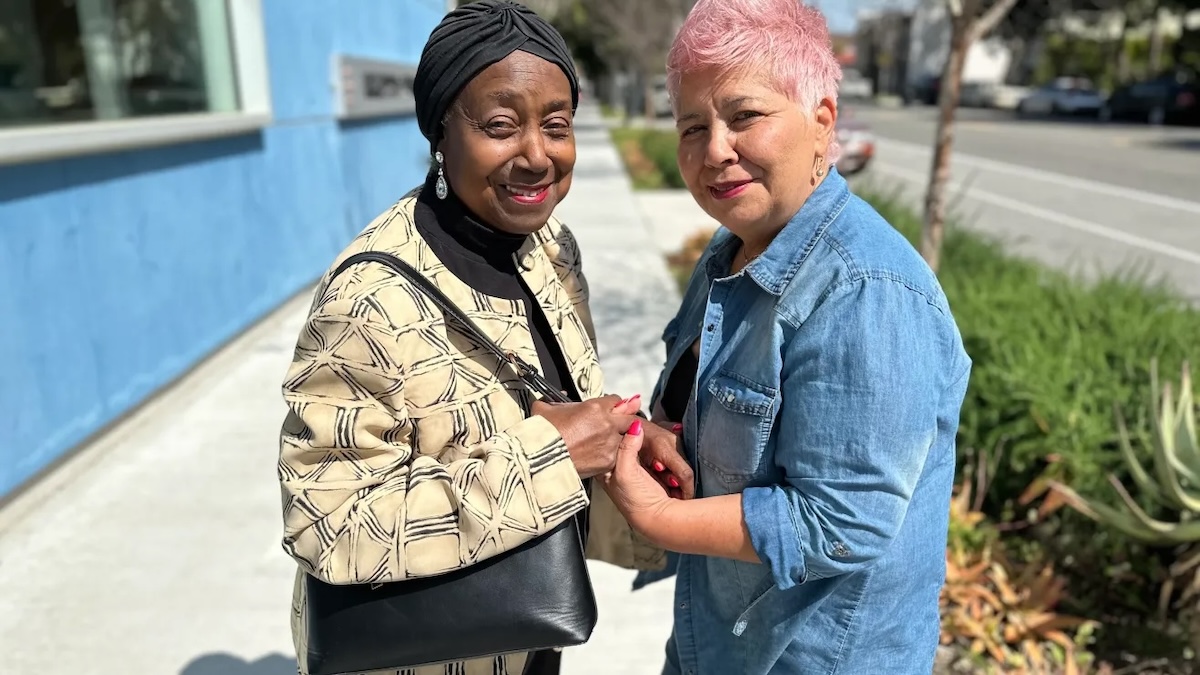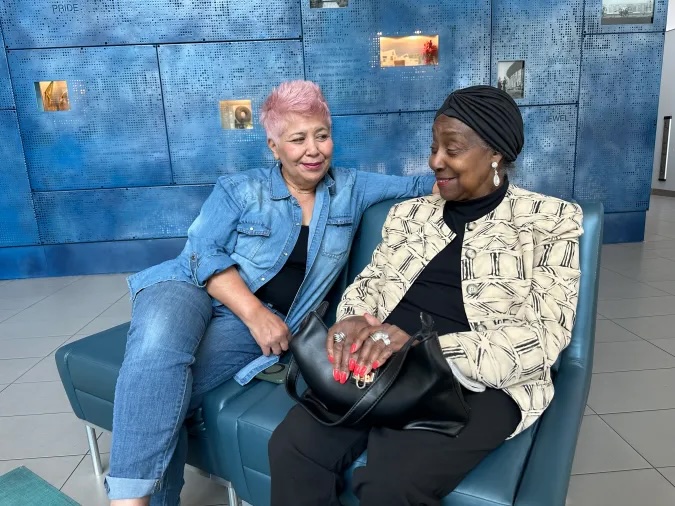Lea este artículo en español
From Monday to Friday, Violeta Olivares drives about an hour to get to her job as a home caregiver. For just over a year, she has cared for Joan McBride, an 85-year-old retired elementary school teacher who suffers from dementia.
“At first, I thought I wasn’t going to do it, because of the cultural difference. I am Latina, and Joan is African American. I didn’t know what her relatives would think, I didn’t know what to say or what not to say. It was a little difficult for me, I think it was for them too, but we adapted and today we have a great relationship.”
In the mid-80s, Violeta emigrated to the United States from her home in Chorombo Alto, a small rural community in Chile. At 62 years old, she has been caring for older adults for almost a decade.
“For six years I took care of a person in his house. During the pandemic, I took care of my sister who suffers from Alzheimer’s. I took care of her for two years; and a year and three months ago, I started taking care of Joan,” she says.
Years ago, Violeta formed Club de Oro, together with Patricia Guerrero, a club that, with the support of other volunteers, offered free entertainment services to older Latino adults in Los Angeles. But they closed the Club when the Covid-19 pandemic hit.
Violeta says she has felt a calling to care for older people since she was a child. “Protecting and caring for the most vulnerable is something innate in me,” she says.
Her workday begins at 7 in the morning and ends at 7 in the evening. She leaves home shortly before 6 in the morning from Santa Clarita, in the north of Los Angeles County to arrive on time in Inglewood, a city in the southwest of the same county.
“I work 12 hours a day.”
Violeta says that normally when she arrives at Joan’s house, she is still sleeping.
“I start preparing breakfast, and almost always Joan gets up alone, and in her pajamas comes to see me in the kitchen. Usually, she bathes alone, but I am on the side of the shower, as a precaution, watching her.”
She’s also there as Joan gets dressed. “I let her dress, trying to make her independent. I have to adjust her clothes well and help her button them up.”
After the bath, breakfast comes, and since Joan suffers from hypertension, Violeta prepares food for her that is not high in salt. Then come the medications.
“A few days a week, we go to the Inglewood Senior Center together. Since I am already over 60 years old, they also accept me, and we do the activities together at the Inglewood Senior Center.”
Other days, she takes Joan to the park to walk and relax a little.
“Many people are surprised to see us interact and ask me if I know someone who can take care of their parents.”
Sometimes, both women go shopping at the mall together. There are days when they go to eat at a restaurant. Sometimes, they go to another place where seniors gather to exercise.
“I also take her to the hair salon every two weeks, and we go to get her manicures and pedicures done.”
Part of Violeta’s job also involves taking Joan to her doctor and dentist visits, in addition to preparing daily meals.
“No later than 5:30 in the afternoon, Joan is already having a snack, because she takes a long time to eat her food. Before I leave, I give her medications and get her ready for bed. If she is sleepy, I leave her in bed, and if not, she stays up for a while with her family. “She lives with a daughter and her son-in-law.”
Violeta says that the biggest challenge she has faced occurred when on one occasion Joan’s blood pressure rose too high. “I spoke to her daughter and we took her to the hospital emergency room.”
From then on, she says that wherever she goes with Joan, she brings a device to measure her blood pressure. “Whenever we go out, I check her blood pressure and if it’s a little high, we wait for it to go down.”
Violeta says that being a caregiver gives her a sense of satisfaction, though she admits it is a job that requires her constant attention.
“I never leave Joan alone. If I go to the bathroom, I take her with me. If she goes to the bathroom, I’m there by her side. Wherever we go, we hold hands to minimize the risk of a fall or accident.”
Part of her job is to inform her daughter of every step she takes with her mother.
“I make sure she is aware of everything I am doing. If the pressure is a little high, I take a photo and send it to her so that she is aware of everything her mother is experiencing.”
After finishing her work, during the hour-long drive back to her home in Santa Clarita, Violeta is grateful that the day ended well.
“I am thankful that within Joan’s health conditions, I left her healthy. And I go with a heart full of satisfaction because I helped a human being who gave everything, with her work and who raised her children, to be better in her last years.”
Being a caregiver fills her with joy.
“You feel like you are doing your bit to make this world better for the people who gave everything in their lives.”
Violeta receives her salary from Joan’s health insurance while the home care jobs she held in the past were paid for by In-Home Supportive Services (IHSS) covered by the state of California.
To work with older adults, Violeta has only taken first aid courses. That’s why she was very interested when she learned that the California Department of Aging is offering completely free online training for paid and unpaid caregivers to equip them with greater skills and pave the way for them to access new professional possibilities.
CalGrows training is available through August 30. Caregivers can enroll in the program online at calgrows.org or by phone at (888) 991-7234 or by email at help@calgrows.org.
The courses offered are in nine different languages includingEnglish, Spanish, Armenian, Cantonese, Korean, Mandarin, Tagalog, Russian and Vietnamese to help meet the needs of California’s diverse population.
Renita Polk, in charge of implementing the CalGrows program at the Department of Aging, said during a recent conference hosted by Ethnic Media Services that the issue of caregiving is very important because California’s population is aging and the number of Californians over 60 years old is projected to reach 10.8 million by 2031.
Caregivers and home health workers, predominantly people of color and women, are the backbone of California’s healthcare system, and their role will only grow as our aging population rapidly grows.
This story was originally published by La Opinión and was produced with support from The California Department of Aging’s CalGrows program.






